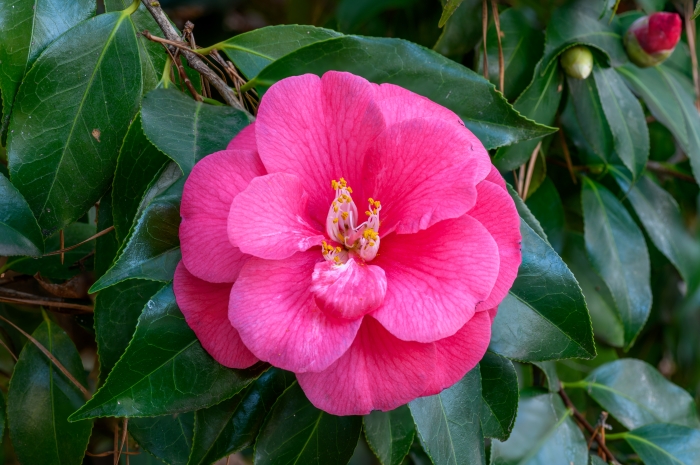Japanese Camellia
(Camellia japonica)
Japanese Camellia (Camellia japonica)
/
/

PumpkinSky
CC BY-SA 3.0


































































Estimated Native Range
Summary
Japanese Camellia is valued for its attractive, long-lasting flowers and glossy evergreen foliage, making it a popular choice for ornamental plantings, formal gardens, and as a specimen plant. It is also used for creating hedges and screens. In cultivation, it requires acidic, well-drained soil and benefits from protection against strong winds and hot afternoon sun. While it prefers part shade, it can tolerate full sun in cooler climates. Camellia japonica is susceptible to pests like scale insects and camellia petal blight, and requires good air circulation to minimize disease risks. There are numerous cultivars available, offering a range of flower forms and colors.CC BY-SA 4.0
Plant Description
- Plant Type: Tree, Shrub
- Height: 7-12 feet
- Width: 5-10 feet
- Growth Rate: Slow
- Flower Color: Pink, Red, White
- Flowering Season: Fall, Spring, Winter
- Leaf Retention: Evergreen
Growth Requirements
- Sun: Part Shade
- Water: Medium
- Drainage: Slow, Medium
Common Uses
Bee Garden, Bird Garden, Border Plant, Butterfly Garden, Deer Resistant, Edible*Disclaimer: Easyscape's listed plant edibility is for informational use. Always verify the safety and proper identification of any plant before consumption., Fragrant, Hedges, Hummingbird Garden, Potted Plant, Salt Tolerant, Showy Flowers, Street Planting
Natural Habitat
Understory of evergreen broadleaf forests in East Asia
Other Names
Common Names: Common Camellia, 동백나무
Scientific Names: , Camellia japonica, Thea japonica, Camellia florida, Camellia japonica var. japonica, Camellia japonica var. decumbens, Camellia japonica var. hortensis, Camellia japonica var. macrocarpa, Camellia hozanensis, Camellia japonica var. hozanensis
GBIF Accepted Name: Camellia japonica L.